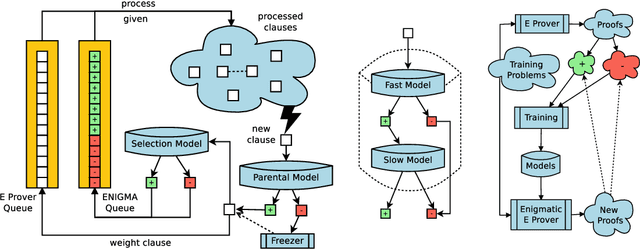Zarathustra Goertzel
Czech Technical University in Prague
MizAR 60 for Mizar 50
Mar 12, 2023



Abstract:As a present to Mizar on its 50th anniversary, we develop an AI/TP system that automatically proves about 60\% of the Mizar theorems in the hammer setting. We also automatically prove 75\% of the Mizar theorems when the automated provers are helped by using only the premises used in the human-written Mizar proofs. We describe the methods and large-scale experiments leading to these results. This includes in particular the E and Vampire provers, their ENIGMA and Deepire learning modifications, a number of learning-based premise selection methods, and the incremental loop that interleaves growing a corpus of millions of ATP proofs with training increasingly strong AI/TP systems on them. We also present a selection of Mizar problems that were proved automatically.
Fast and Slow Enigmas and Parental Guidance
Jul 14, 2021



Abstract:We describe several additions to the ENIGMA system that guides clause selection in the E automated theorem prover. First, we significantly speed up its neural guidance by adding server-based GPU evaluation. The second addition is motivated by fast weight-based rejection filters that are currently used in systems like E and Prover9. Such systems can be made more intelligent by instead training fast versions of ENIGMA that implement more intelligent pre-filtering. This results in combinations of trainable fast and slow thinking that improves over both the fast-only and slow-only methods. The third addition is based on "judging the children by their parents", i.e., possibly rejecting an inference before it produces a clause. This is motivated by standard evolutionary mechanisms, where there is always a cost to producing all possible offsprings in the current population. This saves time by not evaluating all clauses by more expensive methods and provides a complementary view of the generated clauses. The methods are evaluated on a large benchmark coming from the Mizar Mathematical Library, showing good improvements over the state of the art.
ENIGMAWatch: ProofWatch Meets ENIGMA
May 23, 2019



Abstract:In this work we describe a new learning-based proof guidance -- ENIGMAWatch -- for saturation-style first-order theorem provers. ENIGMAWatch combines two guiding approaches for the given-clause selection implemented for the E ATP system: ProofWatch and ENIGMA. ProofWatch is motivated by the watchlist (hints) method and based on symbolic matching of multiple related proofs, while ENIGMA is based on statistical machine learning. The two methods are combined by using the evolving information about symbolic proof matching as an additional information that characterizes the saturation-style proof search for the statistical learning methods. The new system is experimentally evaluated on a large set of problems from the Mizar Library. We show that the added proof-matching information is considered important by the statistical machine learners, and that it leads to improvements in E's Performance over ProofWatch and ENIGMA.
ProofWatch: Watchlist Guidance for Large Theories in E
May 19, 2018



Abstract:Watchlist (also hint list) is a mechanism that allows related proofs to guide a proof search for a new conjecture. This mechanism has been used with the Otter and Prover9 theorem provers, both for interactive formalizations and for human-assisted proving of open conjectures in small theories. In this work we explore the use of watchlists in large theories coming from first-order translations of large ITP libraries, aiming at improving hammer-style automation by smarter internal guidance of the ATP systems. In particular, we (i) design watchlist-based clause evaluation heuristics inside the E ATP system, and (ii) develop new proof guiding algorithms that load many previous proofs inside the ATP and focus the proof search using a dynamically updated notion of proof matching. The methods are evaluated on a large set of problems coming from the Mizar library, showing significant improvement of E's standard portfolio of strategies, and also of the previous best set of strategies invented for Mizar by evolutionary methods.
 Add to Chrome
Add to Chrome Add to Firefox
Add to Firefox Add to Edge
Add to Edge